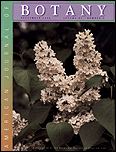Related Research Articles
Dale Sanders, FRS was Director of the John Innes Centre, an institute for research in plant sciences and microbiology in Norwich, England.

A biologist is a scientist who conducts research in biology. Biologists are interested in studying life on Earth, whether it is an individual cell, a multicellular organism, or a community of interacting populations. They usually specialize in a particular branch of biology and have a specific research focus.

The American Journal of Botany is a monthly peer-reviewed scientific journal which covers all aspects of plant biology. It has been published by the Botanical Society of America since 1914. The journal has an impact factor of 3.038, as of 2019. As of 2018, access is available through the publisher John Wiley & Sons (Wiley). From 1951 to 1953, Oswald Tippo served as its editor; the current editor is Pamela Diggle.

Susan Randi Wessler, ForMemRS, is an American plant molecular biologist and geneticist. She is Distinguished Professor of Genetics at the University of California, Riverside (UCR).

Annals of Botany is a monthly peer-reviewed scientific journal publishing experimental, theoretical and applied papers on all aspects of plant biology. The current (2022) Chief Editor is Rowan Sage, replacing John Seymour (Pat) Heslop-Harrison. The journal is owned and managed by the Annals of Botany Company, a non-profit educational charity registered with the Charity Commission for England and Wales. It is published monthly through Oxford University Press in paper form and online, and is paid for primarily by institutional annual subscriptions. Regular extra issues, published free-of-charge, focus on topical themes. The journal does not levy page charges but authors may choose to pay a standard fee to secure open access status for their papers. According to Journal Citation Reports, in 2019 Annals of Botany’s impact factor was 4.005 and was ranked 27th out of 234 journals in the Plant Sciences category. The Journal's Eigenfactor was 0.01652, its H-Index 165 and the SCImago score 1.615. Also owned by the educational charity, Annals of Botany has two sister journals, AoB Plants, an online only open access botanical journal and in silico PLANTS, an online open access journal devoted to plant modelling. It is also closely associated with the informal online plant science publication Botany One.
The Botanical Society of America (BSA) represents professional and amateur botanists, researchers, educators and students in over 80 countries of the world. It functions as a United States nonprofit 501(c)(3) membership society.
Genes to Cells is a peer-reviewed scientific journal that publishes original research on the molecular mechanisms of biological events. The journal has been published since 1996 by Wiley-Blackwell on behalf of the Molecular Biology Society of Japan.

A moss bioreactor is a photobioreactor used for the cultivation and propagation of mosses. It is usually used in molecular farming for the production of recombinant protein using transgenic moss. In environmental science moss bioreactors are used to multiply peat mosses e.g. by the Mossclone consortium to monitor air pollution.
The Histochemical Society (HCS) is an academic society that was founded on March 24, 1950 at a meeting organized by Ralph D. Lillie of the National Institutes of Health. The idea for the Society arose during the 1949 Biological Stain Commission meeting at which a symposia encompassing anatomy, cytology, pathology and biochemistry was proposed by Lillie, Charles Leblond and Edward Dempsey. Lillie became the first editor of HCS's journal, Journal of Histochemistry and Cytochemistry.
George Michael Coupland FRS is a Scottish plant scientist, and Research Scientist and Director of the Max Planck Institute for Plant Breeding Research.
The Association of Applied Biologists (AAB) is a United Kingdom biological science learned society. From its foundation in 1904 until 1934, the institution was the Association of Economic Biologists. It publishes research and holds conferences in different specialisms of applied biology.
In molecular biology mir-390 microRNA is a short RNA molecule. MicroRNAs function to regulate the expression levels of other genes by several mechanisms.

Catherine Rosemary Martin is a Professor of Plant Sciences at the University of East Anglia and project leader at the John Innes Centre, Norwich, co-ordinating research into the relationship between diet and health and how crops can be fortified to improve diets and address escalating chronic disease globally.

The Journal of Experimental Botany (JXB) is a peer-reviewed scientific journal published by Oxford University Press on behalf of the Society for Experimental Biology. It covers research on plant biology, focusing on molecular physiology, molecular genetics, and environmental physiology. Some of its content is available under an open access licence. The editor-in-chief is John Lunn.
Volker Roemheld was a German agricultural scientist, plant physiologist and soil biologist at Hohenheim University.

Govindjee is an Indian-American scientist and educator. He is Professor Emeritus of Biochemistry, Biophysics and Plant Biology at the University of Illinois at Urbana-Champaign, where he taught from 1961 until 1999. As Professor Emeritus since 1999, Govindjee has continued to be active in the field of photosynthesis through teaching and publishing. He is recognized internationally as a leading expert on photosynthesis.

Liam Dolan is the Sherardian Professor of Botany in the Department of Biology at the University of Oxford and a Fellow of Magdalen College, Oxford.
Plant Biotechnology Journal, an Open Access journal, publishes high-impact original research and incisive reviews with an emphasis on molecular plant sciences and their applications through plant biotechnology. It was established in 2003 and is published by Wiley-Blackwell in association with the Society for Experimental Biology and the Association of Applied Biologists. The editor-in-chief is Henry Daniell. According to the Journal Citation Reports, the journal has a 2021 impact factor of 13.263, ranking it 5th out of 238 journals in the category "Plant Sciences" and 8th out of 158 journals in the category "Biotechnology & Applied Microbiology". As an Open Access journal, articles are accessible globally without restriction. To cover the cost of publishing, Plant Biotechnology Journal charges a publication fee.

The Plant Journal is a peer-reviewed scientific journal of plant science published by Wiley-Blackwell for the Society for Experimental Biology. It was established in 1991 and is currently edited by Lee Sweetlove. The journal is published twice per month.
Jessica Polka is a biochemist and the Executive Director of ASAPbio, a non-profit initiative promoting innovation and transparency via preprints and open peer review. She was one of the organizers of a recent meeting they held on scholarly communication.
References
- 1 2 SEB. "About Us". www.sebiology.org. Retrieved 2022-10-28.
- ↑ "Information about the Society for Experimental Biology (SEB)", Comparative Toxicogenomics, Advances in Experimental Biology, vol. 2, Elsevier, 2008, pp. v, doi:10.1016/s1872-2423(08)00015-x, ISBN 978-0-444-53274-9 , retrieved 2022-10-28
- ↑ SEB. "Special Interest Groups". www.sebiology.org. Retrieved 2022-10-28.
- ↑ "Scientific Meetings". Homepage. Society for Experimental Biology.
- ↑ "Publications". Homepage. Society for Experimental Biology.
- ↑ "The Plant Journal". The Plant Journal. doi:10.1111/(ISSN)1365-313X.
- ↑ "Plant Biotechnology Journal". Plant Biotechnology Journal. doi:10.1111/(ISSN)1467-7652.
- ↑ "Contact Us". Society for Experimental Biology, Charles Darwin House, 12 Roger Street, London WC1N 2JU. Retrieved July 15, 2017.
- ↑ "Contact us". Royal Society of Biology, Charles Darwin House, 12 Roger Street, London WC1N 2JU. Retrieved July 15, 2017.
- ↑ "SEB Magazine". Society for Experimental Biology. Retrieved July 15, 2017.